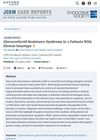Diagnostic Approach to Low-Renin Hypertension
May 2018
in “
Clinical Endocrinology
”

TLDR Recent genetic insights show that low-renin hypertension includes a range from essential hypertension to secondary or familial forms, affecting diagnosis and treatment.
The document from June 6, 2018, reviews the diagnostic approach to low-renin hypertension (LRH), which is present in about 30% of hypertensive patients. It emphasizes the importance of differential diagnosis based on family history, serum aldosterone, and plasma potassium levels, as each form of LRH requires specific targeted therapy. The paper discusses various conditions associated with LRH, including an autosomal dominant condition with a mutation in the NR3C2 gene, Pseudohypoaldosteronism type 2 (Gordon's syndrome), and low renin essential hypertension (LREH). It also explores the role of single nucleotide polymorphisms (SNPs) in LREH. The conclusion is that recent genetic insights have altered the classical view of LRH, indicating a spectrum between low renin essential hypertension and secondary or familial forms such as primary aldosteronism, Liddle syndrome, and AME syndrome, which has important diagnostic and therapeutic consequences.






